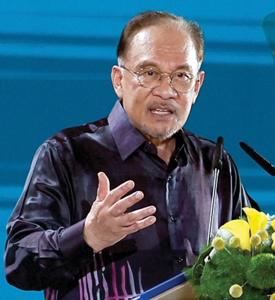The last week of May marked an important landmark in the shift in the global economy to the East when countries representing over 2 billion people and a combined economy of over US$ 25 trillion came together to chart a new path for a peaceful and prosperous world through civilisational dialogue and cooperation, a term the West finds somewhat difficult to understand.
The landmark meeting in the Malaysian capital Kuala Lumpur brought together the leaders of the 10-nation Association of South East Asian Nations (ASEAN), the six-member Gulf Cooperation Council (GCC) and the world’s second biggest economy, China.

Malaysian Prime Minister
Anwar Ibrahim
In 2024, ASEAN-China trade stood at US$ 1 trillion while GCC-China trade was over US$ 288 billion. With a vast potential for trade expansion, the leaders from both regions spoke about the potential of the region to foster regional stability and lead in economic globalisation.
In his opening address, Malaysian Prime Minister Anwar Ibrahim talked about opening up a new chapter in Global South dialogue and cooperation. “This is a meeting of minds, people who want to develop their countries, who believe in independence, in rights, in democracy and who want to enhance trade, increase investments,” he said.
Speaking at the same session, Chinese Premier Li Qiang called on China, ASEAN and GCC countries to jointly forge an example in openness, development cooperation and cross-civilisation integration by creating a model of cross-region openness, noting that the population and economic aggregate of China as well as countries of the ASEAN and the GCC account for approximately one quarter of the world’s total population.
Traditional United States (US) ally Singapore’s Prime Minister Lawrence Wong called upon the three partners to forge deeper ties to unlock new pathways for economic cooperation amidst geopolitical turbulence and uncertainty. Pointing out that ASEAN will become the world’s fourth largest economic bloc by 2030, he said that this new grouping can drive global growth by increasing cooperation in new areas such as digital technology, Artificial Intelligence (AI) and renewable energy such as solar, geothermal and wind.
Belt and Road Initiative
The fact is that the summit participants as a whole have expertise in all these areas and it is a matter of coordinating its implementation as opposed to hegemonic power play. Both Malaysia and China have also emphasised promoting cultural dialogue and understanding, taking inspiration from the ancient Silk Routes (land and maritime) where trade and culture interacted seamlessly and peacefully thousands of years ago. China is keen to emphasise this with its new avatar of the Belt and Road Initiative (BRI) accompanied by its ‘Global Civilisational Initiative’ (GCI). BRI is also called the Global Development Initiative (GDI).
The West’s attempt to denigrate the BRI as a “debt trap” has backfired. In his Summit opening remarks, Premier Anwar referred to the rich trading histories shared by the three parties, from the Silk Road to the Malacca Sultanate flourishing as a critical entrepot (free trade hub) linking the East and the West. “Today, ASEAN carries forward that legacy on a broader scale, emerging as a dynamic crossroads of global commerce, innovation and opportunity,” said Premier Anwar.
“America’s determination to contain China [through tariffs and other measures] is forcing many countries towards an uncomfortable decision long avoided: choosing a side,” notes Peter Chang, a visiting Senior Fellow with ISEAS – Yusof Ishak Institute in Singapore.
“As both US allies and adversaries recalibrate their positions, the world is witnessing a profound geopolitical reconfiguration. Trump’s disruptive “America First” isolationist agenda has accelerated efforts to develop alternative economic frameworks, with nations seeking to insulate themselves from Washington’s unpredictable policies, argued Chang in a commentary published in Hong Kong’s South China Morning Post (SCMP), adding that the ASEAN-GCC-China partnership is “a crucial step in advancing the Developing World’s new vision”.
China’s Global Times (GT) newspaper noted that the leaders’ pledged to further deepen BRI cooperation, in areas such as connectivity, economy and trade, industrial and supply chains, agriculture, energy, finance, Green Economy and the Digital Economy.
“They also pledged to strengthen mutual learning among civilisations, carry out closer multilateral cooperation, and advance trilateral integration for strong, inclusive, and realising the Sustainable Development Goals (SDGs), contributing to the building of a community with a shared future” the GT said. The latter referred to China’s often stated aim of development cooperation as a win-win process for the Global South.
Unity will triumph over isolationism
Chen Hong, Executive Director of the Asia Pacific Studies Centre at the East China Normal University, told GT: “It is not only a crucial milestone for regional cooperation in Asia but also a collective declaration by Global South nations under the shadow of unilateralism, asserting that multi-polarity and equal cooperation represent the prevailing will of the people, and that unity will inevitably triumph over isolationism.”
Riaz Khokhar, a political scientist at the University of Gothenburg in Sweden writing in the SCMP argues that the trilateral partnership now being forged aligns smartly with China’s BRI, leveraging ASEAN’s consumer markets and GCC’s energy wealth.
“ASEAN’s resources, the GCC’s financial clout and China’s manufacturing dominance constitute complementary strengths that can forge a robust supply chain ecosystem. Raw materials, such as Indonesia’s nickel and Malaysia’s palm oil, complement China’s manufacturing capacity, while the GCC’s Sovereign Wealth Funds, worth a collective US$ 5 trillion, can finance critical projects,” he said.
These are not pipedreams. As Khokhar points out, in April, Qatar’s Investment Authority and Indonesia Sovereign Wealth Fund Danantara announced a US$ 4 billion fund to invest in Indonesia’s renewable energy, healthcare and technology sectors.
That will see ASEAN supplying raw material for China’s electric vehicle battery production (China’s CATL and BYD are world leaders in this sector) with GCC funding. Trilateral investments in ASEAN’s digital economy could link China’s digital payments systems with GCC’s Islamic Finance networks, which will create a “robust digital ecosystem”, says Khokhar.
The Kuala Lumpur summit was a welcome break from the East Asia Summit and the Singapore’s Shangri-La Security Dialogue (that took place at the same time) where Western leaders come and lecture about so-called “security issues” in the region, and the need to expand Asian countries’ defence budgets. There was no such talk in Kuala Lumpur nor in the regional media coverage of the Summit.
“Trilateral cooperation between ASEAN, China, and the GCC is likely to deepen and extend into new sectors, reinforcing a pragmatic partnership model built on complementary strengths’, said Muhammad Zulfikar Rakhmat, Director of China-Indonesia Desh at the Jakarta based Centre of Economic Law Studies in a commentary published by the China Global South Project.
“This framework provides a solid foundation for regional collaboration, focusing on infrastructure, technology, and sustainable development.” [IDN-InDepthNews]









